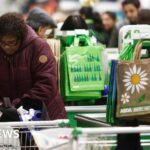 Getty Images
Getty ImagesThe US central bank is expecting weaker growth this year as it warns President Donald Trump’s tariffs are “clearly” driving up prices.
The Federal Reserve released the new forecasts while keeping interest rates unchanged, saying it wanted to wait to better understand the impact of the White House policies.
That decision, which was widely expected, kept the Federal Reserve’s benchmark interest rate hovering around 4.3%, where it has stood since December.
Fed chairman Jerome Powell said that the economy still appeared healthy, despite a sharp downturn in sentiment and “remarkably high” uncertainty.
However, speaking after the Fed’s rates announcement on Wednesday, Powell warned that tariffs were likely to slow growth and hinder the bank’s efforts to keep prices stable, noting recent data showing a rise in goods prices.
“Clearly some of it, a good part of it, is coming from tariffs,” he said.
“Progress is probably delayed for the time being,” he added.
Though it kept interest rates unchanged on Wednesday, the Fed said it would slow down selling assets, such as government debt, in a move that effectively offers more support for the economy.
Since taking office in January, Trump has announced blitz of new tariffs while also calling for big cuts to taxes, regulation, and government spending.
Economists have long warned that some of those policies could cause prices to rise, at least in the short-term, and raise uncertainty for businesses.
Analysts say the concerns have also helped to drive a sell-off in the stock market, with the S&P 500 falling 10% from February back to levels last seen in September.
Trump has acknowledged there could be “a little disturbance” from his tariffs, but says the policies will lead to long-term growth.
The dynamic has added to the challenges facing the Fed, which has spent much of the last three years trying to keep prices stable and avoid economic downturn.
It hiked borrowing costs significantly starting in 2022, aiming to cool the economy and ease the pressures pushing up prices.
Inflation, the rate of price increases, has since fallen to 2.8% as of February, but remains above the bank’s 2% target.
Recent surveys also suggest that public expectations for inflation have risen, which could make the bank’s job stabilising prices more difficult.
Households expecting prices to rise have incentive to buy now. But that can fuel inflation, as firms respond to the increased demand by raising prices further.
“The problem the US faces is that inflation remains a primary risk and is showing signs of consumer expectations becoming unanchored from the 2% target,” said Lindsay James, investment strategist at Quilter.
“Leading indicators of demand may be slowing in the US, but inflation persists and risks spiralling if the proposed economic policies continue.”
The forecasts showed policymakers now expect inflation to stand at 2.7% at the end of this year, up from the 2.5% they had predicted in December.
They are also expecting growth of just 1.7% this year, down from the 2.1% previously anticipated.
Policymakers are still indicating they expect to cut rates by the end of the year.





